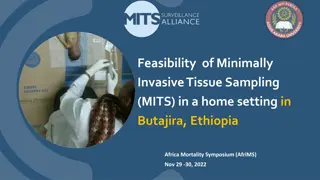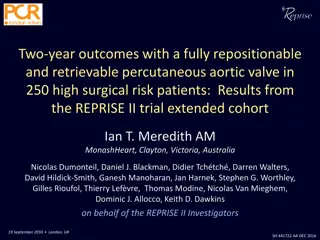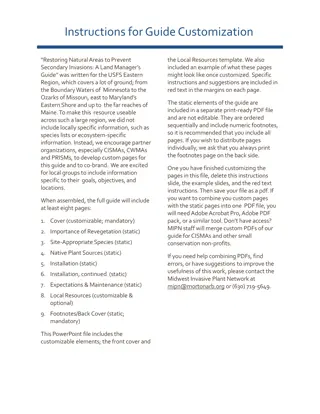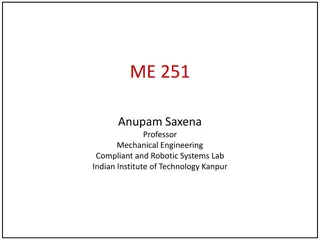UK Mini Mitral Trial: Minimally Invasive Thoracoscopic Approach vs Conventional Sternotomy for Mitral Valve Repair
The UK Mini Mitral Trial compares the outcomes of minimally invasive thoracoscopic-guided right minithoracotomy versus conventional sternotomy for mitral valve repair. The trial aims to determine if physical function improvement post-surgery at 12 weeks is superior in the minimally invasive approach. Secondary objectives include assessing physical function at 6 weeks, mitral valve repair rates, quality of repair, and adverse events. The study methodology involves randomizing suitable patients to either approach with follow-up for one year. Through this trial, researchers seek to define the optimal surgical approach for mitral valve repair and assess patient recovery outcomes.
Download Presentation

Please find below an Image/Link to download the presentation.
The content on the website is provided AS IS for your information and personal use only. It may not be sold, licensed, or shared on other websites without obtaining consent from the author.If you encounter any issues during the download, it is possible that the publisher has removed the file from their server.
You are allowed to download the files provided on this website for personal or commercial use, subject to the condition that they are used lawfully. All files are the property of their respective owners.
The content on the website is provided AS IS for your information and personal use only. It may not be sold, licensed, or shared on other websites without obtaining consent from the author.
E N D
Presentation Transcript
The UK Mini Mitral Trial Minimally invasive thoracoscopically-guided right minithoracotomy versus conventional sternotomy for mitral valve repair: a multicentre randomised controlled trial Professor Enoch Akowuah @EnochAkowuah1
Disclosure Statement of Financial Interests No relevant financial relationships with any commercial entity
Minimally invasive versus conventional sternotomy at 12 weeks post surgery
Background The best surgical approach for mitral valve repair is widely debated Minimally Invasive MVrep via mini thoracotomy is preferred by patients However there are significant question marks which centre on can you repair as many ? can you repair them as well ? is it as safe ? The emergence of percutaneous strategies to treat DMR and the need for trials to determine which procedures benefits specific patients groups make defining the optimum surgical approach an urgent priority
Objectives Primary The primary objective was to determine if physical function and associated return to usual activities measured by change in SF-36 physical functioning scale from baseline to 12 weeks following index surgery was superior in Mini versus Sternotomy once I m assured of surgical expertise, the key question influencing my choice of procedure is speed of recovery of physical function after surgery Secondary Physical function at 6 weeks Physical activity and sleep efficiency measure by accelerometery at 6 and 12 weeks Mitral valve repair rates Quality of Mitral valve repair (rate of moderate or severe MR at 12 weeks and 1 year) Adverse events (Death, stroke, heart failure, hospitalisation, and repeat intervention on the mitral valve )
Trial Methodology Expertise based superiority RCT Potentially eligible patients reviewed by Multi-Disciplinary Heart Team (MDT) DMR Suitable for both approaches Eligibility patients were randomised 1:1 to a Mini or Conventional expert Patients had to move surgeons All had intra op TOE MVrep techniques were at the discretion of the surgeon Follow-up for 1 year post surgery including SF-36v2 physical function scores measured by a blinded researcher Echocardiogram early (within 12 weeks) and at 1 year after surgery assessed by Core Laboratory Physical activity and sleep efficiency measured by accelerometers for 1 week at a time Follow-up every at 6, 12, 18, 24, 38, 52 weeks (post-intervention) with phone calls from the research team.
Participating sites 1. Royal Infirmary of Edinburgh, Edinburgh 2. Blackpool Teaching Hospital, Blackpool 3. James Cook Hospital, Middlesbrough 4. Liverpool Chest and Heart Hospital, Liverpool 5. Derriford Hospital, Plymouth 6. Bristol University Hospital, Bristol 7. Harefield Hospital, Uxbridge 8. Hammersmith Hospital, London 9. Kings College Hospital, London 10. Basildon University Hospital, Basildon 1 3 2 4 10 7 9 6 8 5
Inclusion criteria Adult ( 18 years old at consent) patients with degenerative mitral valve disease, requiring isolated MVr (patients requiring concomitant surgery for Atrial Fibrillation and/or Patent Foramen Ovale (PFO) closure will be included). Written informed consent. Fit for cardiac surgery and cardiopulmonary bypass.
Participant flow Screening Total Total Patients Screened 1167 Total Patients Ineligible 602 Total Patients Declined 231 Total Patients Missed 4 Total Patients Randomised 330
Surgical expertise 28 surgeons were approved by the Trial Steering Committee as experts able to perform surgery in the trial Experts had to have completed 50 procedures Surgeon Expertise Sternotomy (n=16) Mini (n=12) Total (n=28) Number of years performing the operation prior to performing surgery in the trial (IQR;min-max) 14.5 (IQR 11.25;4-26) 7.5 (IQR 6.5; 2.5-13) 9 (IQR 8.5; 1.5-26) Number of operations performed prior to performing surgery in the trial (IQR;min-max) 162 (IQR 300;59-1000) 86 (IQR 145; 50-500) 110 (IQR 166.5; 50-1000)
Characteristic Conventional Sternotomy Minithoracotomy Baseline Characteristics (N=166) (N=163) Demographic Age at randomisation yr Male Sex no. (%) Race no. (%) 66.99 11.51 111 (68.1) 67.29 10.13 118 (71.1) KEY MESSAGES White Non white 158 (96.9) 5 (3.1) 26.2 4.21; 160 166 (100) 0 (0) 26.5 4.20; 165 Patients in both groups were similar BMI mean SD; no. Clinical no./total no. (%) History of Atrial Fibrillation History of Heart Failure History of Stroke History of previous MI History of Chronic Obstructive Pulmonary Disease Average age 67 69/160 (43.1) 45/160 (28.1) 13/160 (8.1) 5/160 (3.1) 69/165 (41.8) 42/165 (25.5) 7/165 (4.2) 6/165 (3.6) AF 40% Characteristic*, ** Conventional Sternotomy Minithoracotomy 11/160 (6.9) 14/165 (8.5) (N=166) (N=163) Women 30% Asthma History of Peripheral Vascular Disease History of Pulmonary Hypertension Moderate (vs No) Severe (vs No) NYHA functional class III/IV In-house urgent patient Euroscore II mean SD; no. Baseline physical function (SF-36 PF score) Low Medium (vs Low) High (vs Low) 13/160 (8.1) 1/160 (0.6) 24/150 (16) 16/150 (10.7) 8/150 (5.3) 77/150 (51.3) 18/150 (12) 1.7 1.43; 150 17/165 (10.3) 4/165 (2.4) 30/162 (18.5) 17/162 (10.5) 13/162 (8) 87/162 (53.7) 14/162 (8.6) 1.72 1.67; 162 Demographic Age at randomisation yr Male Sex no. (%) Race no. (%) 66.99 11.51 111 (68.1) 67.29 10.13 118 (71.1) NYHA III/IV 50% White Non white 158 (96.9) 5 (3.1) 26.2 4.21; 160 166 (100) 0 (0) 26.5 4.20; 165 EuroScore II 1.7 BMI mean SD; no. 36 (22.1) 58 (35.6) 69 (42.3) 36 (21.7) 60 (36.1) 70 (42.2)
Baseline TTE Sternotomy n/N(%) Mini n/N(%) Total n/N(%) Variable MR Severity Mild 0/103(0%) 8/105(7.62%) 97/105(92.38%) 2/107(1.87%) 0/106(0%) 7/107(6.54%) 100/107(93.46%) 2/109(1.83%) 0/209(0%) 15/212(7.08%) 197/212(92.92%) 4/216(1.85%) Moderate KEY MESSAGES Severe Missing 92% had severe MR Location of Mitral Valve Pathology 5/106(4.72%) 101/106(95.28%) 2/109(1.83%) 106/109(97.25%) 7/215(3.26%) 207/215(96.28%) Type I Type II 96% had Type II MV pathology Type IIIa (leaflet restriction rheumatic) Type IIIb (leaflet restriction ischemic) 0/106(0%) 1/109(0.92%) 1/215(0.47%) 65% had isolated P2 prolapse 1/106(0.94%) 0/109(0%) 1/215(0.47%) 2/106(1.89%) 1/107(0.93%) 1/109(0.92%) 0/109(0%) 3/215(1.4%) 1/216(0.46%) Other 23% had bileaflet prolapse Missing Location of Mitral Pathology 24/105(22.86%) 8/105(7.62%) 28/108(25.93%) 8/108(7.41%) 52/213(24.41%) 16/213(7.51%) Bileaflet involvement Isolated anterior leaflet Isolated posterior 68/105(64.76%) 71/108(65.74%) 139/213(65.26%) leaflet 5/105(4.76%) 2/107(1.87%) 1/108(0.93%) 1/109(0.92%) 6/213(2.82%) 3/216(1.39%) Leaflets normal Missing
Operative data Conventional Sternotomy Mini Operative Data no/total no% (n=163) (n=166) Mitral valve repair 142/146 (97.3) 153/160 (95.6) AF surgery 20/69 (30%) 21/69 (30%) TV surgery 10/111 (9) 2/120 (1.7) KEY MESSAGES Repair technique Resection 28/146 (19.2) 10/157 (6.4) Mini procedure took more time Chords 39/146 (26.7) 22/157 (14) X clamp time 11 minutes Premeasured loops 48/146 (32.9) 89/157 (56.6) Edge to Edge 4/146 (2.7) 8/157 (5.1) CPB time 30 minutes Mitral valve ring size mm., mean SD; no. CPB time m., mean SD; no. 32.73 2.56; 142 31.5 2.9; 153 Procedure time 44 minutes 102.01 74.59; 146 134.77 41.04; 159 Aortic cross clamp time m., mean SD; no. Duration of procedure m., mean SD; no. Repeat bypass run for valve re repair or replacement 74.53 24.52; 146 85.6 30.82; 158 184.34 42.65; 145 228.73 56.38; 159 7/146 (4.8) 5/160 (3.1)
Change in PF from baseline at up to 52 weeks ** ** * * * * ** * For Mini PF T-scores increase significantly from baseline to 6 weeks and increased throughout the year. For Sternotomy PF T-scores at 6 weeks are not significantly different from baseline, however they become significantly different from 12 weeks and increase further throughout the year.
Primary Outcome: the difference in the change in PF from baseline to 12 weeks between groups was not significant The mean difference in physical function (T-score) from baseline between groups: 0.675 (-1.89,3.26); 0.61
Echocardiographic outcomes MR reduced to grade none or mild for 95% of participants in both groups at 12 weeks and 92% at 52 weeks. At 52 weeks 3 Sternotomy participants and 1 Mini participant had severe MR At 52 weeks, in both groups, left ventricular dimensions and volumes reduced significantly compared to baseline with no significant differences between groups
Early outcomes safety (up to 12 weeks) Conventional Sternotomy Minithoracotomy Odds Ratio (95%CI); p-value Death 4*(2.5) 1 (0.6) 0.24 (0.03,2.2); 0.2 0.19 (0.02,1.67); 0.13 Stroke with permanent deficit 5 (3.1) 1 (0.6) MI** 1 (0.6) 0 (0) - Tracheostomy 0 (0) 3 (1.8) - 0.63 (0.14,2.92); 0.55 Renal Impairment AKIN criteria (150% increase over baseline /- replacement therapy) 4 (2.5) 3 (1.8) 1.19 (0.26,5.47); 0.82 Prolonged ventilation (>48 Hrs) 3 (1.8) 4 (2.41) ICU LOS (hours) median (IQR) 21.7 (9.2) 23.03 (21.6) P=0.07 1.25 (0.62,2.52); 0.54 Proportion of prolonged CICU stay (>48 hours) 19 (11.7) 21 (12.7)
Mini patients had a reduced length of stay Conventional Sternotomy Minithoracotomy Odds Ratio (95%CI); p-value Hospital LOS - median (IQR) 6 (3) 5 (3) p=0.003 Early discharge (<=4 days post- surgery) 25 (15.3) 55 (33.1) 2.81 (1.6,4.94); <0.001
Days alive and at home (DAOH) was higher for MINI Sternotomy Minithoracotomy Diff (95% CI); p-value* (N=163) (N=166) Days alive and out of hospital at 30 days after surgery mean SD; n 22.38 5.13; 147 23.57 4.45; 161 1.05 (1.01,1.11); 0.03 Days alive and out of hospital at 90 days after surgery mean SD; n 80.52 14.17; 147 82.7 9.96; 161 1.03 (1,1.05); 0.03 DAOH is an important measure of quality. It accounts for: The initial hospital stay if prolonged by peri-op complications Readmissions due to inappropriate discharges or complications (e.g. wound infections) Discharge to nursing home or rehabilitation facilities or any institutionalised care Deaths Now recognised as an important outcome for trials and used as a primary outcome in key trials
Late safety outcomes (up to 1 year) V Conventional Sternotomy Minithoracotomy Odds Ratio (95%CI); p-value Patients: No. (%) 4 (2.5) 5 (3.1) 1 (0.6) Patients: No. (%) 4 (2.4) 5 (3) 0 (0) Death Heart failure hospitalisation at 1 year Repeat mitral valve surgery at 1 year Number of deaths, repeat surgery on the MV, HHF at 1 year 0.98 (0.24,4.05); 0.98 0.98 (0.27,3.51); 0.97 - 10 (6.1) 9 (5.4) 0.88 (0.34,2.25); 0.78 KEY MESSAGES There was no difference in important safety outcomes at 1 year Death A repeat operation Heart failure
Quality of life outcomes at 6 and 12 weeks KEY MESSAGES Quality of life score fell after surgery in both groups but less in the Mini than Conventional The differences were small and of uncertain clinical significance
Summary of findings First and largest multicentre RCT. Expertise based randomisation to account for the learning curve was successfully performed. The difference in the change in PF from baseline to 12 weeks between groups was not significant Physical function improves from baseline to 6 weeks in Mini but in Sternotomy patients. Moderate-Vigorous PA and sleep efficiency were significantly greater with Mini at 6 weeks. Reduced post-operative LOS for Mini. Early discharge more than twice as likely with Mini. DAOH was greater for Mini at 30 and 90 days Small differences in QOL in favour of Mini at all time points (Full cost effectiveness analysis awaited) High repair rate in both arms 96% and echo outcomes at 1 year were excellent (93% mild MR or less). Rates of Death, HFH, reintervention on the mitral valve at 1 year were similar and low.
Conclusions Mini MVr is as safe and effective as sternotomy MVr for DMR. Recovery from baseline to 6 weeks is may be better with Mini. At 12 weeks the mean change in physical function from baseline is the same The findings should give confidence to patients and clinicians and aid adoption of Mini MVRep .























